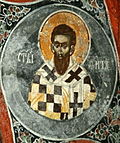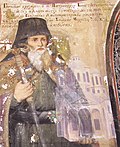Top Qs
Timeline
Chat
Perspective
August 25 (Eastern Orthodox liturgics)
From Wikipedia, the free encyclopedia
Remove ads
August 24 - Eastern Orthodox liturgical calendar - August 26

All fixed commemorations below are observed on September 7 by Eastern Orthodox Churches on the Old Calendar.[note 1]
For August 25, Orthodox Churches on the Old Calendar commemorate the Saints listed on August 12
Saints
- Apostle Titus of the Seventy Disciples, first Bishop of Crete (1st century)[1][2][3][4][note 2]
- Saints Barses (378) and Eulogius (c. 386), Bishops of Edessa, and St. Protogenes, Bishop of Carrhae (c. 387), Confessors.[1][5][6]
- Saints John the Cappadocian (520)[5][7] and Epiphanius (535), Patriarchs of Constantinople.[5][8][3][9]
- Saint Menas, Patriarch of Constantinople (552)[3][10][11]
- Saint John, Bishop of Karpathos (7th century)[1][12][note 3]
- Synaxis of Hierarchs of Crete, Bishops of Gortyna:[1][5][13]
- Cyril (c. 303)
- Eumenius (7th century) (see also: September 18)
- Andrew of Crete, Archbishop (740)
Remove ads
Pre-Schism Western saints
- Saint Geruntius of Italica, a missionary in Spain in the Apostolic Age, Bishop of Talco (Italica, near Seville) and martyr (c. 100)[14][note 4]
- Martyrs Eusebius, Pontian, Vincent and Peregrinus, in Rome (c. 192)[14][note 5]
- Saints Nemesius and Lucilla, a deacon, and his daughter martyred in Rome under Valerian (c. 260)[14][note 6]
- Saint Genesius of Rome (Genesius the Actor), an actor in Rome who took part in a satire on Orthodox baptism, was suddenly converted and martyred (c. 286 or c. 303)[14][note 7]
- Saint Genesius of Arles (Genès), martyr (303)[1][14][note 8][note 9]
- Saint Maginus (Magí), martyr (304)[14][15][note 10]
- Saint Marcian of Saignon, founder of the monastery of St Eusebius in Apt (485)[14]
- Saint Aredius of Limousin (Yrieix, Yriez), Gaul (591)[1][5][14][note 11]
- Saint Patricia of Naples, virgin (c. 665)[14][15][note 12]
- Saint Ebba the Elder, Abbess of Coldingham, Northumbria (683)[1][5][14][16][note 13]
- Saint Hunegund (c. 690)[note 14]
- Saint Warinus (Guarinus, Warren), son of St Sigrada, martyred in France by the tyrant Ebroin who was at war with his brother St Leodegarius (7th century)[14]
- Saint Gregory of Utrecht, Abbot of St. Martin Monastery in Utrecht (775)[1][5][14][15][note 15]
Remove ads
Post-Schism Orthodox saints
- Venerable Gennadius Scholarius, Patriarch of Constantinople (c. 1473)[5][3][9]
New martyrs and confessors
Other commemorations
- Translation of the relics (580) of Apostle Bartholomew (1st century) from Anastasiopolis to Lipari.[1][17][18]
- Translation of the relics (580?) of Martyr Sabbas of Venethalon (Venetalus) (1st century)[3][19][note 17]
- Translation of the relics (c. 860) of St. Hilda of Whitby (680)[1][5]
- Repose of Abbess Magdalene of Sevsk Convent (1848)[1]
- Repose of Monk Benjamin of Valaam (1848)[1]
- Repose of Abbot Nikon (Vorobiev) of Gzhatsk (1963)[1][note 18]
Remove ads
Icon gallery
- Apostle Titus, first Bishop of Crete.
- Saint Eumenes, Bishop of Gortyna
- Saint Andrew, Archbishop of Crete
- Saint Gennadius Scholarius, Ecumenical Patriarch of Constantinople
Notes
- The notation Old Style or (OS) is sometimes used to indicate a date in the Julian Calendar (which is used by churches on the "Old Calendar").
The notation New Style or (NS), indicates a date in the Revised Julian calendar (which is used by churches on the "New Calendar"). - Little is known about his life. He probably lived in the 7th century AD. In the churches of the island Karpathos there are many murals and Icons of John as a saint. He was officially ranked to the Orthodox Hagiologion on 20 August 1985. He is said to be the author of the following work, which is contained in the Philokalia:
- "For the Encouragement of the Monks in India who had Written to Him, One Hundred Texts"
- (in Greek) «Πρὸς τοὺς ἀπὸ τῆς Ἰνδίας προτρέψαντας μοναχοὺς παρακλητικός, 100 κεφάλαια».
- See also: (in Greek) Άγιος Ιωάννης ο Καρπάθιος. Βικιπαίδεια. (Greek Wikipedia).
- "At Rome, in the time of the emperor Commodus, the holy martyrs Eusebius, Pontian, Vincent, and Peregrinus, who were first racked, distended by ropes, then beaten with rods and burned on their sides. As they continued faithfully to praise Christ, they were scourged with leaded whips until they expired."[15]
- The translation of their relics is observed on October 31.
- "Also, at Rome, St. Genesius, martyr, who embraced the profession of actor while he was yet a Pagan. One day he was deriding the Christian mysteries in the theatre in the presence of the emperor Diocletian; but by the inspiration of God he was suddenly converted to the faith and baptized. By the command of the emperor, he was forthwith most cruelly beaten with rods, then racked, and a long time lacerated with iron hooks, and burned with fire-brands. As he remained firm in the faith of Christ, and said: "There is no king besides Christ. Should you kill me a thousand times, you shall not be able to take Him from my lips or my heart," he was beheaded, and thus merited the palm of martyrdom."[15]
- A notary in Arles in France who refused to put on record an imperial decree against Orthodox Christians and declared that he himself believed in Christ. He was martyred under Maximian Herculeus.
- "At Aries, in France, another blessed Genesius, who, filling the office of notary, and refusing to record the impious edicts by which Christians were commanded to be punished, threw away his tablets publicly, and declared himself a Christian. He was seized and beheaded, and thus attained to the glory of martyrdom through baptism in his blood."[15]
- Born in Tarragona in Spain, he enlightened the people near his native town and was finally beheaded under Diocletian.
- Born in Limoges in France, he founded Atane in the Limousin, which was later called after him, as also was the village of Saint Yrieux which grew up around the monastery.
- Born in Constantinople and related to the imperial family, in order to escape marriage she went on a pilgrimage to Jerusalem and then to Rome, where she became a nun. She died in Naples in Italy where she is one of the patron-saints.
- Sister of Sts Oswald and Oswy, Kings of Northumbria, she became a nun at Lindisfarne. Having founded the convent of Coldingham, now in Scotland, she became abbess there.
- Forced to marry against her will, she persuaded her bridegroom to accompany her to Rome, where she became a nun. They returned to France and Hunegund entered the convent of Homblières, while her betrothed became a priest.
- Born in Trier in Germany, he met St Boniface when still a child and later became a monk. He became Abbot of St Martin's at Utrecht in the Netherlands and then Bishop of the same city for twenty-two years. St Martin's was a seedbed of saints.
- See: (in Russian) Моисей (Кожин). Википедии. (Russian Wikipedia).
- He is unknown in the Synaxaria and the Menaia. His memory is recorded in the Sinaitic Codex 631 (10th-11th centuries) as follows (translation):
- "... ...are deposited the relics of (Apostle) Bartholomew in Lipari and of the Holy Martyr Saba Venethalon".[20]
- (in Greek) «Τίτου καὶ κατάθεσις λειψάνου Βαρθολομαίου ἐν Σηκῷ τῆς Λιπάρεως καὶ τοῦ Ἁγίου Μάρτυρος Σάβα Βενεθάλων».[21]
- See: (in Russian) Никон (Воробьёв). Википедии. (Russian Wikipedia).
Remove ads
References
Sources
Wikiwand - on
Seamless Wikipedia browsing. On steroids.
Remove ads




